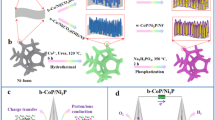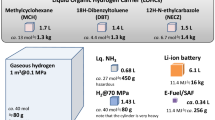Abstract
A novel boron nitrogen monolayer named as inorganic graphenylene (IGP) was proposed for H2 purification, and its stability was confirmed by the calculated cohesive energy and phonon dispersion spectrum. Using the density function theory (DFT) calculations and molecular dynamic (MD) simulations, we found that the IGP membrane can fulfill the requirements of both the high H2 permeance (~10−3 mol/m2 s Pa) and high H2 selectivities (>107) over H2O, CO2, N2, CO, and CH4 at 300 K. Excitingly, the MD results matched well with the DFT calculations including the selectivity, permeance as well as the adsorption properties of different gases.






Similar content being viewed by others
References
PenA MA, Gómez JP, Fierro JLG (1996) New catalytic routes for syngas and hydrogen production. Appl Catal A Gen 144(1–2):7–57
Oetjen HF, Schmidt V, Stimming U, Trila F (1996) Performance data of a proton exchange membrane fuel cell using H2/CO as fuel gas. J Electrochem Soc 143(12):3838–3842
Ockwig NW, Nenoff TM (2007) Membranes for hydrogen separation. Chem Rev 107(10):4078–4110
Pandey P, Chauhan R (2001) membranes for gas separation. Prog Polym Sci 26(6):853–893
Liu G, Jin W, Xu N (2016) Two-dimensional-material membranes: a new family of high-performance separation membranes. Angew Chem Int Ed 55(43):13384–13397
Guan K, Shen J, Liu G, Zhao J, Zhou H, Jin W (2016) Spray-evaporation assembled graphene oxide membranes for selective hydrogen transport. Sep Purif Technol 174:126–135
Zhu L, Chang X, He D, Xue Q, Xiong Y, Zhang J, Pan X, Xing W (2017) Theoretical study of H2 separation performance of two-dimensional graphitic carbon oxide membrane. Int J Hydrog Energy. doi:10.1016/j.ijhydene.2017.04.043
Oyama S, Lee D, Hacarlioglu P, Saraf R (2004) Theory of hydrogen permeability in nonporous silica membranes. J Membr Sci 244(1):45–53
Hu W, Wu X, Li Z, Yang J (2013) Porous silicene as a hydrogen purification membrane. Phys Chem Chem Phys 15(16):5753–5757
Ma Z, Zhao X, Tang Q, Zhou Z (2014) Computational prediction of experimentally possible g-C3N3 monolayer as hydrogen purification membrane. Int J Hydrog Energy 39(10):5037–5042
Song Q, Wang B, Deng K, Feng X, Wagner M, Gale JD, Müllen K, Zhi L (2013) Graphenylene, a unique two-dimensional carbon network with nondelocalized cyclohexatriene units. J Mater Chem C 1(1):38–41
Zhu L, Jin Y, Xue Q, Li X, Zheng H, Wu T, Ling C (2016) Theoretical study of a tunable and strain-controlled nanoporous graphenylene membrane for multifunctional gas separation. J Mater Chem A 4(39):15015–15021
Lu R, Rao D, Lu Z, Qian J, Li F, Wu H, Wang Y, Xiao C, Deng K, Kan E (2012) Prominently improved hydrogen purification and dispersive metal binding for hydrogen storage by substitutional doping in porous graphene. J Phys Chem C 116(40):21291–21296
Jiao Y, Du A, Smith SC, Zhu Z, Qiao SZ (2015) H2 purification by functionalized graphdiyne-role of nitrogen doping. J Mater Chem A 3(13):6767–6771
Shan M, Xue Q, Jing N, Ling C, Zhang T, Yan Z, Zheng J (2012) Influence of chemical functionalization on the CO2/N2 separation performance of porous graphene membranes. Nanoscale 4(17):5477–5482
Lu R, Meng Z, Rao D, Wang Y, Shi Q, Zhang Y, Kan E, Xiao C, Deng K (2014) A promising monolayer membrane for oxygen separation from harmful gases: nitrogen-substituted polyphenylene. Nanoscale 6(17):9960–9964
Perim E, Paupitz R, Autreto P, Galvao DS (2014) Inorganic graphenylene: a porous two-dimensional material with tunable band gap. J Phys Chem C 118(41):23670–23674
Brunetto G, Autreto P, Machado L, Santos B, Dos Santos RP, Galvao DS (2012) Nonzero gap two-dimensional carbon allotrope from porous graphene. J Phys Chem C 116(23):12810–12813
Zhang H, Tong C-J, Zhang Y, Zhang Y-N, Liu L-M (2015) Porous BN for hydrogen generation and storage. J Mater Chem A 3(18):9632–9637
Hankel M, Searles DJ (2016) Lithium storage on carbon nitride, graphenylene and inorganic graphenylene. Phys Chem Chem Phys 18(21):14205–14215
Perdew JP, Burke K, Ernzerhof M (1996) Generalized gradient approximation made simple. Phys Rev Lett 77(18):3865
Grimme S (2006) Semiempirical GGA-type density functional constructed with a long-range dispersion correction. J Comput Chem 27(15):1787–1799
Halgren TA, Lipscomb WN (1977) The synchronous-transit method for determining reaction pathways and locating molecular transition states. Chem Phys Lett 49(2):225–232
Henkelman G, Uberuaga BP, Jónsson H (2000) A climbing image nudged elastic band method for finding saddle points and minimum energy paths. J Comput Chem 113(22):9901–9904
Mayo SL, Olafson BD, Goddard WA (1990) DREIDING: a generic force field for molecular simulations. J Phys Chem 94(26):8897–8909
Jiao Y, Du A, Hankel M, Zhu Z, Rudolph V, Smith SC (2011) Graphdiyne: a versatile nanomaterial for electronics and hydrogen purification. Chem Commun 47(43):11843–11845
Li Y, Liao Y, Chen Z (2014) Be2C monolayer with quasi-planar hexacoordinate carbons: a global minimum structure. Angew Chem Int Ed 53(28):7248–7252
Li JR, Kuppler RJ, Zhou HC (2009) Selective gas adsorption and separation in metal-organic frameworks. Chem Soc Rev 38(5):1477–1504
Blankenburg S, Bieri M, Fasel R, Müllen K, Pignedoli CA, Passerone D (2010) Porous graphene as an atmospheric nanofilter. Small 6(20):2266–2271
Zhang Y, Shi Q, Liu Y, Wang Y, Meng Z, Xiao C, Deng K, Rao D, Lu R (2015) Hexagonal boron nitride with designed nanopores as a high-efficiency membrane for separating gaseous hydrogen from methane. J Phys Chem C 119(34):19826–19831
Li F, Qu Y, Zhao M (2015) Efficient helium separation of graphitic carbon nitride membrane. Carbon 95:51–57
Jiang DE, Cooper VR, Dai S (2009) Porous graphene as the ultimate membrane for gas separation. Nano Lett 9(12):4019–4024
Zhu L, Xue Q, Li X, Jin Y, Zheng H, Wu T, Guo Q (2015) Theoretical prediction of hydrogen separation performance of two-dimensional carbon network of fused pentagon. ACS Appl Mater Interfaces 7(51):28502–28507
Zhu Z (2006) Permeance should be used to characterize the productivity of a polymeric gas separation membrane. J Membr Sci 281(1):754–756
Sun C, Boutilier MS, Au H, Poesio P, Bai B, Karnik R, Hadjiconstantinou NG (2014) Mechanisms of molecular permeation through nanoporous graphene membranes. Langmuir 30(2):675–682
Robeson LM (2008) The upper bound revisited. J Membr Sci 320(1):390–400
Li H, Song Z, Zhang X, Huang Y, Li S, Mao Y, Ploehn HJ, Bao Y, Yu M (2013) Ultrathin, molecular-sieving graphene oxide membranes for selective hydrogen separation. Science 342(6154):95–98
Yu M, Funke HH, Noble RD, Falconer JL (2011) H2 separation using defect-free, inorganic composite membranes. J Am Chem Soc 133(6):1748–1750
Fu J, Das S, Xing G, Ben T, Valtchev V, Qiu S (2016) Fabrication of COF-MOF composite membranes and their highly selective separation of H2/CO2. J Am Chem Soc 138(24):7673
Acknowledgements
This work was supported by the Shandong Provincial Natural Science Foundation (ZR2015BQ009).
Author information
Authors and Affiliations
Corresponding author
Electronic supplementary material
Below is the link to the electronic supplementary material.
Appendix: Supplementary material
Appendix: Supplementary material
Phonon dispersion spectrum of the IGP monolayer, mode of the MD simulation box, structural parameters of the IGP monolayer, adsorption states and transition states for the gases passing through the IGP membrane, final configurations of the gases penetrating through the IGP membrane after 2000 ps, H2 selectivities versus H2 permeance of IGP and other membranes as well as Robeson upper bound. Supplementary material related to this article can be found at.
Rights and permissions
About this article
Cite this article
Xu, J., Zhou, S., Sang, P. et al. Inorganic graphenylene as a promising novel boron nitrogen membrane for hydrogen purification: a computational study. J Mater Sci 52, 10285–10293 (2017). https://doi.org/10.1007/s10853-017-1246-8
Received:
Accepted:
Published:
Issue Date:
DOI: https://doi.org/10.1007/s10853-017-1246-8




